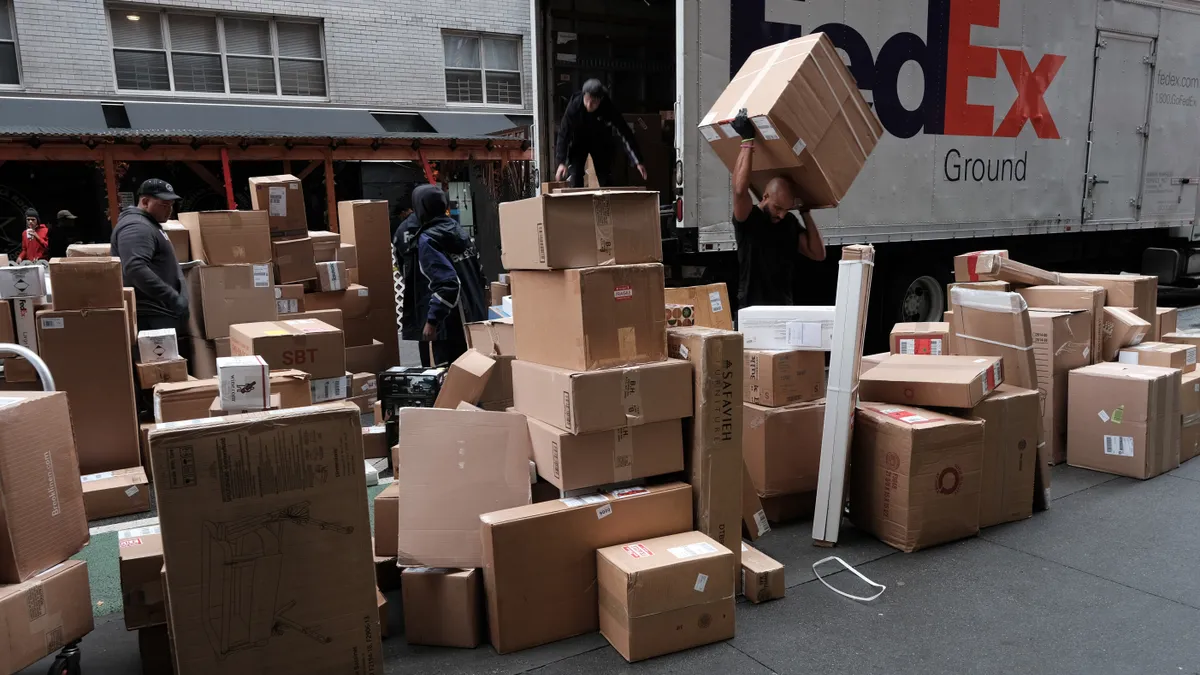Dive Brief:
- New York City will begin testing local delivery hubs this summer to reduce truck traffic and emissions in favor of more sustainable transportation options, according to an April 6 news release from the city's Department of Transportation.
- Microhubs in the city will provide designated curbside or off-street locations for trucks to unload items onto low-emissions transportation modes, like electric vehicles or cargo bikes, for last mile delivery.
- The city DOT will launch up to 20 sites to test both curbside and off-street delivery sites in the program's first phase, beginning this summer and extending into the fall.
Dive Insight:
The Big Apple is rethinking how its city can more effectively handle the rise in business-to-consumer deliveries. Before the COVID-19 pandemic, 40% of deliveries went to residential customers, per a city DOT presentation. Today, that figure is now about 80%.
This surge in activity has sparked concerns about the negative impacts for the city's environment and resident safety as double-parking and sidewalk obstructions become more prevalent.
“New Yorkers are receiving more deliveries than ever before, and we are pursuing creative ways to make these deliveries cleaner, safer, and more efficient by reducing the number of delivery trucks on our roads," Ydanis Rodriguez, New York City's DOT commissioner, said in a statement.
But more deliveries in dense urban areas also challenges the efficiency of carriers' operations, with traffic delays and high fuel and toll costs being common pain points. As a result, delivery providers have already been pursuing creative ways to minimize these issues.
For example, FedEx Express announced in 2022 it expanded electric cart testing to five New York City locations after initial tests showed an increase in deliveries per hour. UPS, Amazon and DHL have also tested cargo bikes in the city, eyeing benefits such as reduced parking fines.
Despite these recent tests, close to 90% of New York City's goods are still moved via truck today, according to the DOT. The microhubs will provide safe spots for drivers to transfer their deliveries onto transport modes that offer reduced emissions and congestion.
“These hubs will help better organize last-mile deliveries and support small and large businesses’ economic recovery as we emerge from the pandemic," Rodriguez said.
Hub location decisions will factor in proximity to truck routes, public transit, bike lane networks and high-density areas with mixed land use. Conceptual designs in the DOT's presentation provide an idea of the preferred features and locations of on-street and off-street hubs.


In the pilot's first phase, the department will monitor hub operations, collect data and refine strategies to make sure implementation and enforcement is equitable for both small and large companies.
Phase two will run from fall 2024 to 2026. Its purpose will include expanding the number of hubs and delivery partners, exploring regulatory changes and gathering lessons to develop a permanent hub program. A final program report is expected to be issued in late 2026.












